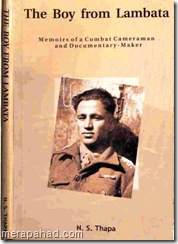The Boy from Lambata
Memories of a Combat Cameraman and Documentary-Maker
Book Review By Kamal Karnatak
 The innocent face of Shri N.S.Thapa (NST) on the cover of the book “The Boy from Lambata” looks like a face of a Hollywood star from a war film but the same innocent face has witnessed lot of ups and down of life. The Autobiographical book of Shri Thapa, "The Boy from Lambata", is not only the account of the life and work of him but also the account of Indian history. His book reflects the changing shades of Indian social , political and bureaucratic landscape . His book shows that success can be achieved by sheer courage, hard work and honesty.
The innocent face of Shri N.S.Thapa (NST) on the cover of the book “The Boy from Lambata” looks like a face of a Hollywood star from a war film but the same innocent face has witnessed lot of ups and down of life. The Autobiographical book of Shri Thapa, "The Boy from Lambata", is not only the account of the life and work of him but also the account of Indian history. His book reflects the changing shades of Indian social , political and bureaucratic landscape . His book shows that success can be achieved by sheer courage, hard work and honesty.
The first thing which comes in mind on hearing the name of the book is the word “Lambata” .NST knows this and begins his book by saying
“Lambata is the name of the house my grand father built on a forlorn ridge in the village of Marh-Manle in Pithoragarh district of Uttarakhand” Lambata means a “long path” and aptly describes its isolated location, far from everywhere; over a kilometer away from the main village ….” .
The boy from the same remote house ;in an unknown village of Northern Hills of India , rose to the various occasions and became the true legend of Indian documentary film history.
We know very little about that boy and his eventful life but we are really indebted to him for giving us the opportunity of going through the various chapters of his life .His life evolves from the place which he describes as “place where a person born poor ,illiterate and fettered to the yoke of his pair of bullocks for life”. His childhood reminds us of the various problems a poor boy faces in the remote villages of hills. The status of education, health facilities, caste-system, social stigmas, traditional bindings, village life style, and status of woman in the society – all appears in the early pages of his book. His father reminds him of a saying “A man born in hills and bullock born in the plains of the India ,face the same fate. One is yoked to go round and oil expeller and the other is yoked to the rocky ,unyielding soil and they both die young”
Life of NST changes when he moves to city with his uncle for further education. After studying at Shilong and Baluchistan he joins the army as a military man and later becomes the English teacher in the army. Fate brings more changes in his life and he ultimately becomes a war cameraman. Then starts the story of world war -II through the eyes of NST. Readers go through the different phases of war in pre-independent era. NST’s romance with the movie camera enables him to go to various places and witness many historic events. His wonderful narration of the events is a treat for the readers of the book. He not only gives the eye-witness account of the events but also substantiate it with historical backgrounds and facts.
He joins the film division after independence and completes the various assignments. His proximity with the then prime minister Pt.Jawahar Lal Nehru brings lot of interesting facts about the life of Nehru . Readers see Nehru in new light and different faces of Nehru comes into the mind. Pt. Nehru’s visits to different countries like Pakistan ,Russia ,Poland and many places were covered by NST and travelogue of every visit is a must read .To that end the book succeeds, and uninitiated readers are provided with a background of the world war-II and post-independent India alongside Nehru’s political career .
Many interesting incidents and anecdotes fill the book. Normally people feel happy with promotions but NST feels otherwise at one occasion .”In 1967, on the 20th anniversary of Indian Independence , my family saw me promoted to the rank of producer ,getting a higher salary and doing lesser work….I sat behind the a table like a glorified clerk and supervised the work of five or six directors…I felt like a bird with clipped wings.”
This book also shows concerns about the deforestation of hills .”With the passage of time forest contractors and timber traders damages the remaining forests . The pattern of rain and snowfall in the hills has changed ,…We the people of India , are guilty of destroying our eco-system by mindless destruction of our forests . We cannot blame the weather-Gods for droughts and famines.”
In nutshell this book is must read for taking bucket full of inspiration from life and work of Mr.N.S.Thapa.
Book: The Boy from Lambata by N.S.Thapa
Publisher: PAHAR
Release Date: 28th september 2004
ISBN: 81-86246-24-X
First Edition :2004
Genre: Nonfiction – Biography – Celebrities
Edited by Ajay Rawat and Sekhar Pathak
Printed By Raghubir Chand for PAHAR,"Parikrama,Talla Danda ,Nainital – 263002
Reviewer: Kamal Karnatak
Contact for Book : books@merapahad.com
==Related==
I do not know how to convert this message in Hindi. But at least I am trying to contact you this way.
By the way, how can you be a ADANA AADAMI when you are doing such a herculian task.